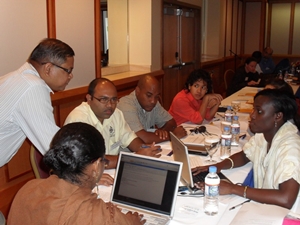Wednesday, June 23rd, 2010 at 3:38 pm
Invasive Alien Species (IAS) are plants, animals or micro-organisms in all major (taxonomic) groups of organisms that are not native to an ecosystem, such as, viruses, fungi, algae, mosses, ferns, higher plants, insects, fish, amphibians, reptiles, birds and mammals. For an alien species to become invasive, it must arrive, survive and thrive. It must successfully out-compete native organisms for food and habitat, spread through its new environment, increase its population and harm ecosystems in its introduced range.
Within each group, numerous species including perhaps as many as 10% of the world’s 300,000 woody plants, have the potential to invade other ecosystems and affect the native ecosystem and those depending on it for a livelihood directly or indirectly. Globally, combating this problem is estimated to cost US$1.4 trillion or 5% of the entire Global GDP annually.
Dr. Seepersad, explained that although the scientists see the Pink Hibiscus Mealy Bug as a success story in integrated pest management, in his view as an economist, the virtual elimination of hibiscus from the ornamental trade is an economic cost that has not been counted – a loss that continues into the future.
Similarly, he explained that the presence of the Red Palm Mite is linked to more than 50% loss of production of coconuts which has resulted in more significant increases in coconut prices. This must also include the cost of road repairs that results from increasing coastal erosion partly due to loss of trees caused by this mite. Additionally the loss of the tourist appeal and the fall out in tourism are all economic costs that must be attributed to invasive species that are affecting palms and other plants in the wild.
Mr. Naitram Ramnanan, Regional IAS Coordinator at CABI Caribbean and Latin America and Manager of the project: Mitigating the Threats of Invasive Alien Species in the Insular Caribbean, pointed out that the objective of the recently concluded regional training exercise was to enhance the capacity of the region to count the economic costs of this serious problem in the region. This he noted was critical to quantifying the problem in order to convince the policy makers to adopt a regional strategy. He alluded to the importance of instituting measures to prevent new IAS from coming into the region and dealing effectively with those that already present and causing serious economic impact.
Over 30 participants from Bahamas, Barbados, Jamaica, Saint Lucia and Trinidad and Tobago indicated that the training was useful and each country has agreed to undertake a complete economic assessment of IAS that are affecting their respective countries. The Global Environment Facility (GEF) via the United Nations Environment Programme (UNEP); Inter-American Institute for Cooperation on Agriculture (IICA); University of the West Indies (UWI) and Florida A and M University (FAMU) all collaborated to support the staging of the seminar.
